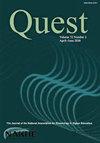Social Theory and Movement Skill Learning in Kinesiology
IF 1.7
3区 教育学
Q2 EDUCATION & EDUCATIONAL RESEARCH
引用次数: 0
Abstract
Across the world participation in physical activity spans a wide-variety of populations all with diverse backgrounds, needs and interests. This includes physical education in schools, sport in clubs, fitness in gyms and dance in studios as well as any number of outdoor pursuits and related leisure activities. Central to individuals’ participation in these varied physical activity forms, expressions and modes is some degree of movement competency. Unsurprisingly, therefore, movement skill learning has become an important area of inquiry for kinesiology scholars across a range of disciplines. Traditionally movement skill learning has been framed within kinesiology as a cognitive process studied primarily under lab-based or experimental conditions. As a result, skill acquisition has been predominantly defined by three common classification systems: the size of the movement, its beginning and end points and the stability of the environment (Schmidt & Wrisberg, 2004). Identifying the size of a movement and the primary musculature involved helps determine if a skill is a gross motor skill (downhill skiing) or a fine motor skill (wrist flick on a throw). Identifying the start and endpoints of a movement helps define the motor skill as discrete (a jump shot) or continuous (running). And identifying a skill based on the stability of the environment where it is being executed defines it as open (playing soccer) or closed (throwing darts). Given these classification systems, researchers began to propose a number of models to explain how learners moved through the process of learning a movement skill. Fitts and Posner (1967), as one of the earliest examples, suggested a three-stage model of skill acquisition. They argued that learners begin in a cognitive stage where their focus is simply to understand the movement problem before them and how they might solve it. After some practice, learners should progress to the associative stage in order to connect the movement they are attempting to learn in step with any emerging environmental demands. Finally, learners should reach the autonomous stage where the skill they have been learning is now something they can execute automatically. A further influence with respect to how movement skill learning has been studied within kinesiology has come from the natural sciences where the hallmarks of good research are grounded in realism: the idea that true knowledge is founded on direct observation of objects, bodies, and/or natural phenomena in controlled, objective laboratory conditions. Biomechanics, for example, drew from engineering principles to analyze biological systems, structures and functions that explained human movement as the result of a series of levers and pulleys. Exercise physiology emerged from the new anatomists who examined how bodies move by dissecting static cadavers. Mathematical laws were also applied to the body运动机能学中的社会理论与运动技能学习
在世界各地,参与身体活动的人群种类繁多,背景、需求和兴趣各不相同。这包括学校的体育教育、俱乐部的运动、健身房的健身和工作室的舞蹈,以及任何数量的户外活动和相关的休闲活动。个人参与这些不同的身体活动形式、表达和模式的核心是一定程度的运动能力。因此,毫不奇怪,运动技能学习已经成为运动机能学学者在一系列学科中研究的一个重要领域。传统的运动技能学习在运动学中被认为是一个主要在实验室或实验条件下研究的认知过程。因此,技能习得主要由三种常见的分类系统来定义:动作的大小、起点和终点以及环境的稳定性(Schmidt & Wrisberg, 2004)。识别一个动作的大小和涉及的主要肌肉组织有助于确定一个技能是大运动技能(下坡滑雪)还是精细运动技能(投掷时挥动手腕)。确定一个动作的起点和终点有助于将运动技能定义为离散的(跳投)或连续的(跑步)。根据执行技能的环境的稳定性来确定技能,将其定义为开放(踢足球)或封闭(扔飞镖)。考虑到这些分类系统,研究人员开始提出一些模型来解释学习者如何在学习运动技能的过程中移动。Fitts和Posner(1967)作为最早的例子之一,提出了一个三阶段的技能习得模型。他们认为,学习者从认知阶段开始,他们的重点仅仅是理解他们面前的运动问题,以及如何解决它。经过一些练习,学习者应该进入联想阶段,以便将他们试图学习的动作与任何新出现的环境要求联系起来。最后,学习者应该达到自主阶段,在这个阶段,他们一直在学习的技能现在可以自动执行。关于如何在运动机动学中研究运动技能学习的进一步影响来自自然科学,其中良好研究的标志是建立在现实主义基础上的:真正的知识是建立在对物体、身体和/或自然现象的直接观察之上的,这些观察是在受控的、客观的实验室条件下进行的。例如,生物力学从工程原理出发,分析生物系统、结构和功能,将人体运动解释为一系列杠杆和滑轮的结果。运动生理学产生于新的解剖学家,他们通过解剖静态的尸体来研究身体是如何运动的。数学定律也适用于身体
本文章由计算机程序翻译,如有差异,请以英文原文为准。
求助全文
约1分钟内获得全文
求助全文
来源期刊

Quest
社会科学-运动科学
CiteScore
4.50
自引率
14.30%
发文量
16
期刊介绍:
Quest is the official journal of the National Association for Kinesiology in Higher Education (NAKHE). It is the leading journal for interdisciplinary scholarship for professionals in kinesiology in higher education. Quest provides a public forum for scholarship, creative thought, and research relevant to a broad range of interests held by faculty and leaders in higher education today.
Quest publishes: 1) manuscripts that address issues and concerns relevant and meaningful to the field of kinesiology; 2) original research reports that address empirical questions that are contextualized within higher education and hold significance to a broad range of faculty and administrators in kinesiology; and 3) reviews of literature and/or research of interest to one or more sub-disciplines in kinesiology. Quest does not publish papers focused on sport (e.g., amateur, collegiate, professional) that are contextualized outside of kinesiology in higher education.
 求助内容:
求助内容: 应助结果提醒方式:
应助结果提醒方式:


